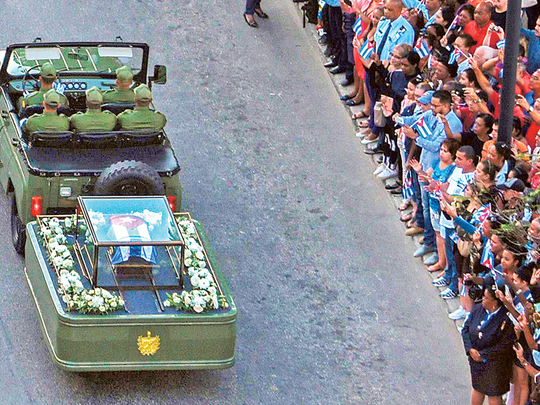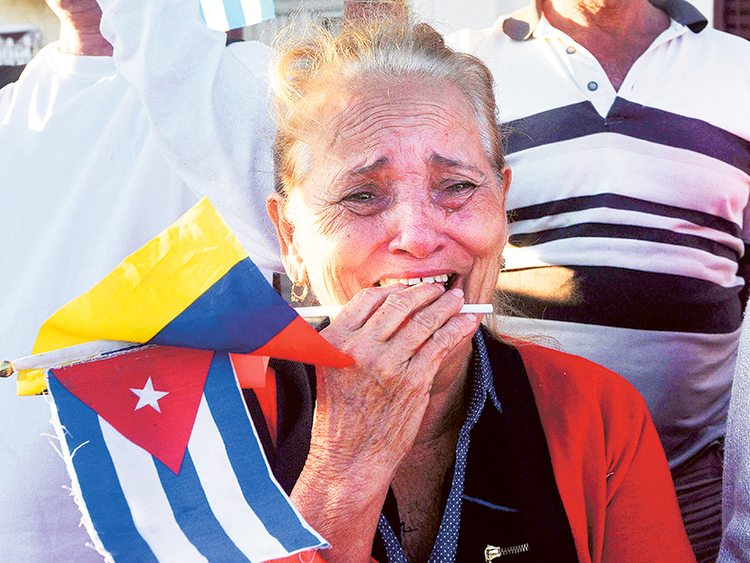
Havana The ashes of Fidel Castro begin a four-day journey across Cuba Wednesday to his final resting place, retracing the late communist leader’s revolution victory tour of 1959.
The “caravan of freedom” will leave from Havana, making symbolic stops along the 950-kilometer trek that will end in the eastern city of Santiago de Cuba over the weekend.
Thousands of Cubans lined the streets of Havana Wednesday morning, some sleeping on sidewalks overnight, to bid goodbye to Fidel Castro as his ashes began a four-day journey across the country he ruled for nearly 50 years.
The crowds at the rally and along Wednesday’s procession route were a mix of people attending on their own and groups of Cubans organised by their government workplaces in group trips that are not strictly obligatory but create strong pressure to attend.
Some groups of government workers slept on the streets because all public transport had been commandeered to move people to Castro-related activities.
“We love the commandants and I think it’s our obligation to be here and see him out,” said Mercedes Antunez, 59, who was bused in by the state athletics organisation from her home in east Havana along with fellow employees.
Cuban state media reported that the urn containing Fidel Castro’s ashes was being kept in a room at the Defence Ministry where President Raul Castro, Castro’s younger brother and successor, and top Communist Party officials paid tribute.
The trip follows two days of tributes in Havana where hundreds of thousands were encouraged by the government to view a picture memorial to Castro at the Revolution Square.
The commemorations in the capital ended with a massive rally Tuesday night at the square attended by Latin American, African and Caribbean leaders, along with the Greek prime minister — the only European leader at the event.
Raul Castro, 85, closed the rally with a speech thanking world leaders for their words of praise for his brother, whom he called the leader of a revolution “for the humble, and by the humble.”
South African President Jacob Zuma praised Cuba under Castro for its record on education and health care and its support for African independence struggles.
Castro will be remembered as “a great fighter for the idea that the poor have a right to live with dignity,” Zuma told the crowd.
But the presidents of Western powers, and even friendly nations including Russia, China and Iran, sent deputies in their place.
The absences underscored the divisive legacy of a leader who defied the United States, backed guerrilla movements in Latin America and deployed his army to conflicts in Africa during the Cold War.
Leftist Latin American leaders vowed to carry the torch of Castro’s revolution as they addressed the rally on Tuesday night and the crowd chanted “I am Fidel!”
“Today it is up to us to raise the flags of independence of the great fatherland, today it is up to us to hold the flag of dignity and freedom of the people,” said Venezuelan President Nicolas Maduro, whose late mentor, Hugo Chavez, had a special bond with Castro.
Allies praised Castro in almost religious tones, with Bolivian President Evo Morales saying, “Fidel is not dead. ... Fidel is more alive than ever, more necessary than ever.”
Castro’s death, however, comes as Latin America’s left is losing ground.
Maduro is facing a deep economic crisis and fighting opposition attempts to hold a recall referendum, while Brazil’s Dilma Rousseff was impeached in August and a conservative took over in Argentina last year.
Castro — who ruled from 1959 until an illness forced him to hand power to his brother Raul in 2006 — died Friday at age 90.
US President Barack Obama, who along with Raul Castro ended decades of enmity to restore diplomatic relations, did not attend the rally, sending an adviser and a diplomat without the status of a “presidential delegation.”
“We continue to have some significant concerns about the way the Cuban government currently operates, particularly with regard to protecting the basic human rights of the Cuban people,” White House spokesman Josh Earnest said.
Castro’s ashes were placed in a rectangular, dark wood urn that was kept at the armed forces ministry and only shown once on state television.
Inside the memorial, thousands walked through three rooms with near-identical displays featuring the 1962 Alberto Korda photograph of the young Castro in the Sierra Maestra mountains, bouquets of white flowers and an array of Castro’s medals against a black backdrop, framed by honour guards of soldiers and children in school uniforms. The ashes did not appear to be on display.
Signs read: “The Cuban Communist Party is the only legitimate heir of the legacy and authority of the commander in chief of the Cuban Revolution, comrade Fidel Castro.”
“Goodbye commander. Your ideas remain here with us,” 64-year-old retiree Etelbina Perez said between sobs, dabbing at her eyes with a brown handkerchief. “I feel great pain over his death. I owe my entire life to him. He brought me out of the mountains. I was able to study thanks to him.”
The urn will be laid to rest on Sunday at the Santa Ifigenia cemetery, next to the mausoleum of 19th century independence hero Jose Marti.
Before that, Castro’s ashes will travel across the country, taking the reverse route that his band of guerrilla fighters took after defeating dictator Fulgencio Batista.
From January 2 to January 8, 1959, the bearded rebels travelled from Santiago to Havana, stopping in Castro’s home region, Holguin, as well as the cities of Camaguey, Las Tunas, Sancti Spiritus, Santa Clara and Matanzas.
One of the most symbol-filled stops of this last trip will be in Santa Clara, where the ashes of his Argentine comrade-in-arms, Ernesto “Che” Guevara, rest.














